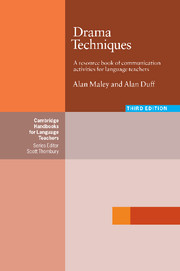Book contents
- Frontmatter
- Contents
- Thanks and acknowledgements
- Introduction
- 1 Getting ready
- 2 Observation
- 3 Working with mime
- 4 Working with the voice
- 5 Working with objects
- 6 Working with visuals
- 7 Working with the imagination
- 8 Working from/into words, phrases, sentences
- 9 Working from/into texts
- 10 Working from/into scenarios and scripts
- 11 Into Performance
- Bibliography
- Index
- Frontmatter
- Contents
- Thanks and acknowledgements
- Introduction
- 1 Getting ready
- 2 Observation
- 3 Working with mime
- 4 Working with the voice
- 5 Working with objects
- 6 Working with visuals
- 7 Working with the imagination
- 8 Working from/into words, phrases, sentences
- 9 Working from/into texts
- 10 Working from/into scenarios and scripts
- 11 Into Performance
- Bibliography
- Index
Summary
This is the third edition of Drama Techniques in Language Teaching. The second edition has been going strong for over 20 years. We are confident that this, the third edition, will be equally popular with teachers world-wide.
The kinds of techniques or activities we advocated in the earlier editions are now well accepted by many teachers, though they were pioneering stuff at the time. Things have moved on, however, and we felt it was time for a completely new edition which would cut out some less useful activities, revamp others and introduce completely new material and ideas.
Why use drama?
It integrates language skills in a natural way. Careful listening is a key feature. Spontaneous verbal expression is integral to most of the activities; and many of them require reading and writing, both as part of the input and the output.
It integrates verbal and non-verbal aspects of communication, thus bringing together both mind and body, and restoring the balance between physical and intellectual aspects of learning.
It draws upon both cognitive and affective domains, thus restoring the importance of feeling as well as thinking.
By fully contextualising the language, it brings the classroom interaction to life through an intense focus on meaning.
The emphasis on whole-person learning and multi-sensory inputs helps learners to capitalise on their strengths and to extend their range. In doing so, it offers unequalled opportunities for catering to learner differences.
It fosters self-awareness (and awareness of others), self-esteem and confidence; and through this, motivation is developed.
Motivation is likewise fostered and sustained through the variety and sense of expectancy generated by the activities.
[…]
Information
- Type
- Chapter
- Information
- Drama TechniquesA Resource Book of Communication Activities for Language Teachers, pp. 1 - 5Publisher: Cambridge University PressPrint publication year: 2005
